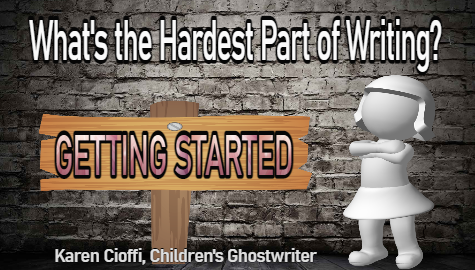The hardest part of writing will most likely be different for different writers.
Many, though, have a hard time getting started.
These writers know they want to write a story.
They may have a character in mind or an idea for a storyline.
The problem is getting started.
To actually sit and write a beginning, middle, and end can be intimidating for many writers. If they’re not intimidated, they may be stumped. This leads to procrastination.
So, how do you overcome the ‘getting started’ blues?
One simple possibility is to just start writing.
Once words and sentences begin to appear on your screen, it opens up to paragraphs, chapters, and so on. This is the seat-of-your-pants method of writing.
The story unfolds before you.
A possible drawback to this method is that you could get stuck.
Your story may be flying along, and then suddenly, BAM. It hits a mountain. You’re not sure how to get over or around the obstacle to continue on with the story.
At this point, you’ll need to think about creating an outline to move forward.
Another excellent method to get started with your story is to create an outline at the get-go. This will help you plot your story.
Before I go on, let me explain what a story plot is.
According to “How to Write a Children’s Book” from The Institute of Children’s Literature, “A plot is really nothing more mysterious than a plan for a story—a sequence of events with a beginning, a middle, and an end. The direction a plot takes may be simple and straightforward, as in a short story for preschoolers. Or it may be complex . . . when intended for young adult readers.”
A solid plot unfolds as your protagonist faces a challenge (conflict), takes action to overcome it, and grows in someway as a result of achieving his goal.
Here’s what it would look like in children’s writing:
-The story is set up, and the characters are introduced (exposition)
-The protagonist faces a significant challenge (conflict)
-Action is taken to overcome the problem (rising action)
–The protagonist makes a choice (climax)
-The protagonist succeeds and grows in some way (resolution)
Okay, let’s get back to the topic of figuring out how to get started writing.
Now that the plot format is understandable, there are steps you can take to ease yourself into the story.
Think of the main character in your children’s story.
-How old is he? (What age group are you targeting – what is the reader’s age? Your protagonist should be at the top age of your target reader. So, if your reader will be 5-8, your protagonist should be 8 or 9.)
-What’s your main character like?
-What problem will he have?
-Is the problem age appropriate?
-What conflicts or obstacles are blocking your protagonist from reaching her goal? You must have conflict in your story.
-List the events and how they will unfold.
-And decide how the story will end.
Using the outline method, you create a GPS for your story. It takes the guesswork out of writing a story. This takes the pressure off.
It’s like painting with dots. The picture is outlined; you simply fill in the dots.
While you can deviate a bit from your outline, you know where you need to get back on track and exactly where you need to end up.
Some writers believe this is the best method for creating solid stories, which have a better chance of getting traditionally published.
The outline method definitely provides a sense of security.
As a pantser, when I rewrote an ancient Chinese folktale, which I titled “Walking Through Walls,” I had a roadmap of where I was going. While I changed the story drastically for today’s children’s market, I knew the basics of the story. This was very helpful.
Also, although I may start chapter books by the seat of my pants, I usually end up creating chapter outlines as I go along.
Writing 600 words or less for a picture book can allow a writer to be a pantser, but it gets tricky when you’re writing 20,000 – 50,000 words.
So, whether you want to let your story write itself (pantser) and hope you don’t get stuck along the way or whether you create an outline first, the most important thing is to START writing.

I’m a working children’s ghostwriter, editor, and coach. I can help turn your story into a book you’ll be proud to be the author of, one that’s publishable and marketable.
Other help I offer is my guided self-study course, FICTION WRITING FOR CHILDREN.
Or you might want an in depth DIY book, HOW TO WRITE A CHILDREN’S FICTION BOOK.
You can contact me at: kcioffiventrice@gmail.com.

Writing Tips from the Book, Story Genius


1 thought on “The Hardest Part of Writing is Actually Starting”